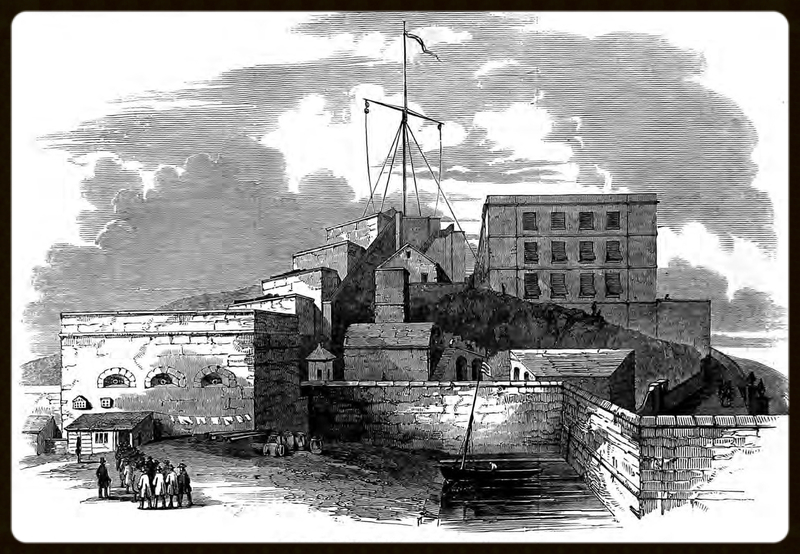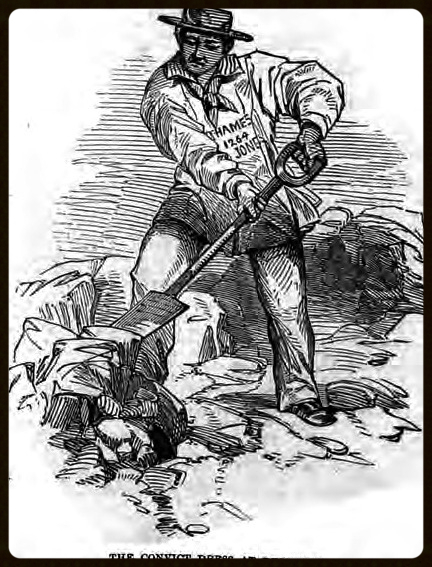
Bermuda, 1848
Bermuda. – The Convict Establishment
Illustrated London News, 17 June 1847
The conviction and consequent transportation of John Mitchell to the islands of Bermuda has invested them with interest. Many of our readers are, perhaps, not aware that for twenty-eight years these islands have been appropriated as a penal colony.
The Bermudas are a cluster of upwards of three hundred small islands, in the North Atlantic Ocean, 580 miles E. by S. ¼ S, from Cape Hatheras, in North America, the nearest point of land, and 645 miles N.E. of Atwood’s Keys, the nearest of the West India Islands. They were discovered, in 1522, by Juan Burmudez, a Spaniard; and Sir George Summers, or Sommers, was driven upon them in 1609, on his voyage to Virginia; hence they are named Burmudas, or Sommers’ Islands, from each of these adventurers.
It is in these islands that Shakespere has laid the scene of his play of “The Tempest,” alluding to them particularly as
“The still vex’d Bermoothes.”
Bishop Berkeley, in 1725, published a scheme for the conversion of the North American savages, by means of a Missionary College to be erected in the Bermudas.
The principal islands are Long Island (chief town Hamilton, the seat of Government), St, George’s, and Ireland Island; the latter a mass of fortifications, principally erected by the labours of the convicts, under the supervision of the Royal Sappers and Miners. The breakwater and fortifications were commenced by the convicts in 1824, and at their completion it was understood that the convicts were to be withdrawn, it not being intended to make Bermuda a penal settlement.
Ireland Island contains a spacious dockyard and arsenal, with their usual appurtenance, and a large “camber,” capable of containing the largest ships of the line. In this camber the convict hulks are moored, viz. the Dromedary, Thames, Coromandel, and Tenedos.
Ireland Island, Fortifications and Dockyard
Illustrated London News, 17 June 1848
© The Genealogist.co.uk
Our Illustration shows the most strongly fortified part of Ireland Island, adjoining the Dockyard; the Breakwater in the foreground (extending about three hundred yards) being met by another at right angles in front of the Dockyard, and forming the camber.
The spacious erection on the eminence is the Casemate Barracks (occupied at present by the 42nd Highlanders), near which is erected the Flag-staff, and Telegraph to St. George’s and Hamilton.
The number of convicts confined at the Bermudas averages 1600, of whom all except those incapacitated by illness, or engaged on board their respective hulks, are employed on the Public Works.
Their employment principally consists of Quarrying and cutting stone for the fortifications. For this labour each man is paid by the Board of Ordnance three-pence per diem; one penny of which he is at liberty to expend in the purchase of the cheap luxuries of the colony, and the remaining two-thirds of his earnings are reserved by the overseers, to be given to him on his liberation.
The convicts are well fed and clothed. Their food consists of alternate rations of ¾lb. of fresh beef and salt pork, with 1 ¼lb. of best wheaten bread, daily; vegetables and pea soup, on alternate days; one pint of cocoa for breakfast, and the same quantity of tea for supper. Until lately they were allowed a quarter of a pint of rum each per diem, but a ration of tea has been substituted for the spirit. A few of the best behaved and qualified convicts are employed on board the hulks as clerks, cooks, servants, carpenters, shoemakers, &c.
The rules for the guidance and observance of the convicts were, until the year 1844, very lax; but owing to a mutinous outbreak on board the Thames, and the subsequent escape of twelve prisoners to the United States of America, the regulations are more stringent.
The punishments inflicted on the convicts for crimes committed on board the hulks, or on the public works, of course vary with the nature of the offence; stoppage of pay, solitary confinement, heavy ironing, and flogging, being the usual inflictions.
No overseer is permitted to inflict more than five dozen lashes at one time, without an order from the Governor of Bermuda (Captain c. Elliot, R.N.), who is ex officio the superintendant of convicts. The best medical attendance is afforded where necessary; and all cases of a serious nature are carried to the Royal naval Hospital, where (in a separate ward) the convict patients enjoy the same treatment bestowed on the sailors and marines of her Majesty’s fleet.
The climate of Bermuda is very healthy, but with this exception, that it is occasionally visited with yellow fever. The last visitation, in 1843, carried off a great number of soldiers, convicts, and civilians.
The Convict Dress at Bermuda
Illustrated London News, 17 June 1848
© The Genealogist.co.uk
The dress of the convicts is suitable to the warmth of the climate, and consists of a frock and trousers of white duck, (with the name and number of the prisoner conspicuously marked thereon), straw hat, shoes, cotton shirt, flannel shirt, and drawers; the latter articles being necessary to absorb the excessive perspiration engendered by exposure to the rays of a tropical sun.
Our Illustrations are from sketches by a gentleman formerly a resident in the Bermudas. They would appear to be almost a paradisiacal region. “Nothing,” says Mr. Moore, “can be more romantic than the little bay of St. George’s; the number of little islets, the singular clearness of the water, and the animated play of the graceful little boats gliding for ever between the islands, and seeming to sail from one cedar grove to another, form, altogether, the sweetest miniature of nature that can be imagined. In the short but beautiful twilight of their spring evenings, the white cottages scattered over the islands, and but partially seen through the trees that surround them, assume the appearance of little Grecian temples, and embellish the poor fisherman’s hut with columns which the pencil of Claude might imitate.”
Such is the country to which Mitchell is now on his passage. His younger brother sailed from Liverpool, on Saturday, in the Britannia, for New York. He purposes, it was conjectured, to proceed to Bermuda, on matters of a family nature, to his brother. The Great Western steam-ship plies regularly between New York and Bermuda, the voyage being about 70 hours.

